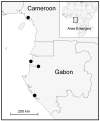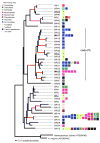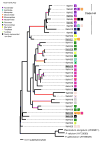Host associations and evolutionary relationships of avian blood parasites from West Africa
- PMID: 18713636
- PMCID: PMC2632718
- DOI: 10.1016/j.ijpara.2008.06.005
Host associations and evolutionary relationships of avian blood parasites from West Africa
Abstract
The host specificity of blood parasites recovered from a survey of 527 birds in Cameroon and Gabon was examined at several levels within an evolutionary framework. Unique mitochondrial lineages of Haemoproteus were recovered from an average of 1.3 host species (maximum=3) and 1.2 host families (maximum=3) while lineages of Plasmodium were recovered from an average of 2.5 species (maximum=27) and 1.6 families (maximum=9). Averaged within genera, lineages of both Plasmodium and Haemoproteus were constrained in their host distribution relative to random expectations. However, while several individual lineages within both genera exhibited significant host constraint, host breadth varied widely among related lineages, particularly within the genus Plasmodium. Several lineages of Plasmodium exhibited extreme generalist host-parasitism strategies while other lineages appeared to have been constrained to certain host families over recent evolutionary history. Sequence data from two nuclear genes recovered from a limited sample of Plasmodium parasites indicated that, at the resolution of this study, inferences regarding host breadth were unlikely to be grossly affected by the use of parasite mitochondrial lineages as a proxy for biological species. The use of divergent host-parasitism strategies among closely related parasite lineages suggests that host range is a relatively labile character. Since host specificity may also influence parasite virulence, these results argue for considering the impact of haematozoa on avian hosts on a lineage-specific basis.
Figures





References
-
- Angehr G, Schmidt B, Njie F, Christy P, Gebhard C, Tchignoumba L, Ombenotori MAE. In: Bird surveys in the Gamba Complex of protected areas. Gabon A, Alonso A, Lee ME, Campbell P, Pauwels OSG, Dallmeier F, editors. Vol. 12. Gamba, Gabon: Biodiversity of an equatorial African rainforest Bulletin of the Biological Society of Washington; 2006. pp. 327–351.
-
- Beadell JS, Gering E, Austin J, Dumbacher JP, Peirce MA, Pratt TK, Atkinson CT, Fleischer RC. Prevalence and differential host-specificity of two avian blood parasite genera in the Australo-Papuan region. Mol Ecol. 2004;13:3829–3844. - PubMed
-
- Beadell JS, Fleischer RC. A restriction enzyme-based assay to distinguish between avian hemosporidians. J Parasitol. 2005;91:683–685. - PubMed
-
- Bensch S, Perez-Tris J, Waldenstrom J, Hellgren O. Linkage between nuclear and mitochondrial DNA sequences in avian malaria parasites: multiple cases of cryptic speciation? Evol. 2004;58:1617–1621. - PubMed
Publication types
MeSH terms
Substances
Grants and funding
LinkOut - more resources
Full Text Sources

